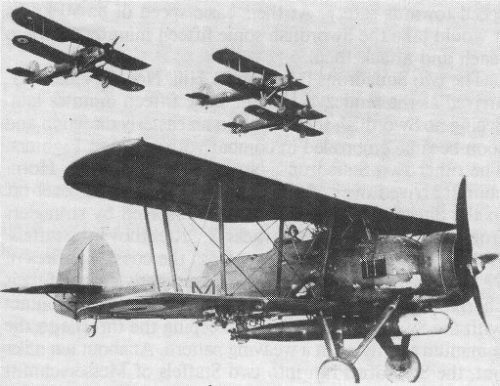- Author
- Burnhams, J.C., RNCC
- Subjects
- Naval Aviation, WWII operations
- Tags
-
- RAN Ships
- None noted.
- Publication
- March 1991 edition of the Naval Historical Review (all rights reserved)
The second Sub-flight of three Swordfish, flying in close ‘vic’ formation was last seen penetrating the outer screen. According to German sources, almost immediately after that the planes were massacred by Focke Wulf FW 190s flown by Jagdgeschwader 26, Staffels.
There were only five survivors from the striking force of eighteen young men who had taken off from Manston earlier that day. The four officers, Sub Lieutenants Edgar F. Lee, Brian W. Rose, Charles M. Kingsmill and Reginald McC. Samples were decorated with the Distinguished Service Order (DSO), an unusual occurrence for such junior officers to, receive this senior award. Leading Airman Donald A. Bunce, the sole surviving non-commissioned airman, received the Conspicuous Gallantry Medal (CGM), this again a relatively rare award. (72 were awarded in World War II, of which only two were members of the Fleet Air Arm).
The Victoria Cross was awarded posthumously to Lieutenant Commander Eugene Esmonde, DSO on the recommendation of Wing Commander Tom Gleave, the Commanding Officer of RAF Manston. This is probably the only time in the history of the Victoria Cross that a Royal Air Force officer has recommended a Royal Naval officer for the award. The recommendation went through the RAF High Command before being passed onto the Admiralty for their own action. This was the only Victoria Cross awarded to the Fleet Air Arm during World War 2. Under contemporary rules governing awards and decorations within the British Armed Services, only two gallantry awards could be recommended and awarded posthumously – the Victoria Cross and Mentioned in Despatches. Accordingly, in strict adherence to the book, each of the remaining twelve men who gave their lives so bravely in this action was merely listed as ‘Mentioned in Despatches’.
After the operation, Admiral Sir Bertram Ramsay, from his Dover Castle Headquarters signalled the Admiralty:
‘In my opinion the gallant sortie of these six Swordfish constitutes one of the finest exhibitions of self sacrifice and devotion that the war has yet witnessed. ‘
Admiration from the German side for the bravery of the Swordfish crews was shown in remarks passed at the time:
Admiral Otto Ciliax, writing in his diary next day…
“The mothball attack of a handful of ancient planes, piloted by men whose bravery surpasses any other action by either side that day.”
Kurt Hoffman, Captain of Scharnhorst…
“It was nothing but suicide for them to fly against these big ships”.
Helmuth Giessler, Navigating Officer on board Scharnhorst…
“Such bravery was devoted and incredible. One was privileged to witness it… They knowingly and ungrudgingly gave their all to their country and went to their doom without hesitation.”
Wilhelm Wolf, a Junior officer on board Scharnhorst…
“What an heroic stage for them to meet their end on. Behind them their homeland, which they have left with their hearts steeled to their purpose is still in view.”
Anon…
“Being familiar with the details of the heroic and dramatic torpedo attack of Eugene Esmonde and his men we can only make a deep bow for such gallantry.”
Finally, a tribute from Wing Commander Tom Cleave…
“Those Swordfish crews were courage personified…”
Went the day well?
We died and never knew
But, well or ill, Freedom
We died for you
Anon
The Fairey Swordfish

- A British carrier based bomber and torpedo carrier in service with the Royal Navy between 1936 and 1945.
- Though outwardly obsolete before the war began, the Swordfish was so robust and flown with such courage and skill, that it established a wonderful record during the war against the German, Italian and Japanese fleets. Even serving in close support roles, firing rockets and dropping bombs.
- Flown by a crew ranging from one to four, but more usually with two or three, the Swordfish could reach around 139 mph on its 690 hp Pegasus engine. It could carry a torpedo, or up to 2000 lbs of bombs or mines, depth charges or rockets.
- Later models were fitted with radar between the landing gear.
In 1940, they sank many warships at Taranto. In 1941 they sank more warships at Cape Matapan and Mediterranean area, crippled the Bismarck and sank their first submarine at Narvik. 1942 saw them make the only possible close attack on the German Fleet, and by 1943 it had helped the Royal Navy submarines to virtually eliminate Axis sea power from the Mediterranean.
Altogether, 2,391 Swordfish were built, and they even outlasted the Albacore, which was originally intended to be its replacement.
There is now only one Swordfish in flying condition remaining, and this is owned by, maintained and based at the Fleet Air Arm Museum at HMS Heron, Yeovilton, Somerset. It is part of the Royal Navy, Fleet Air Arm Historic Flight Display Team and can be seen regularly at air displays up and down the country.




